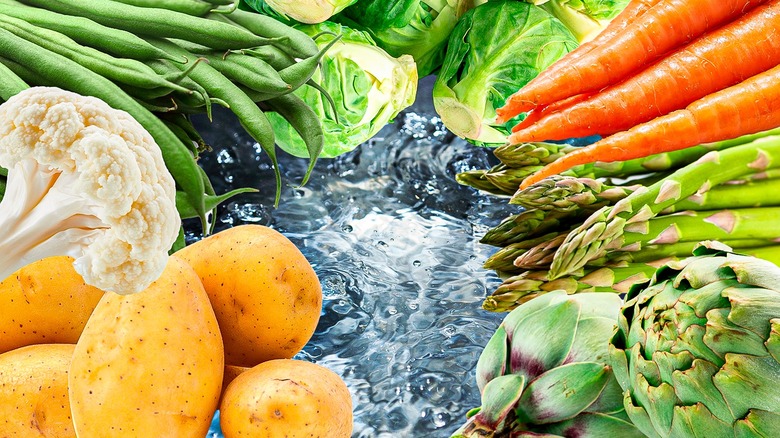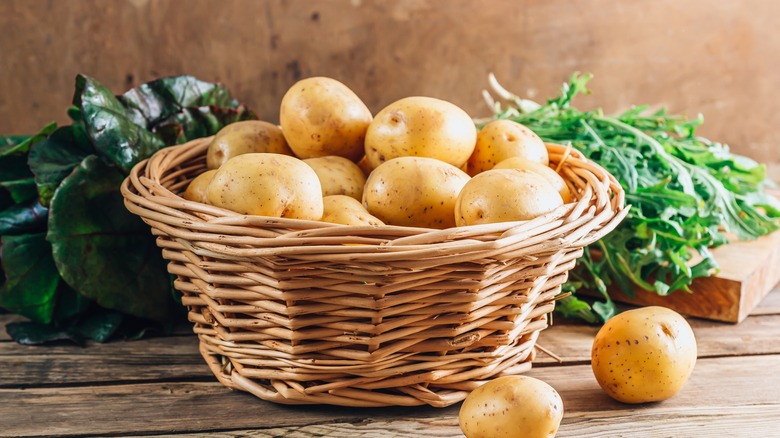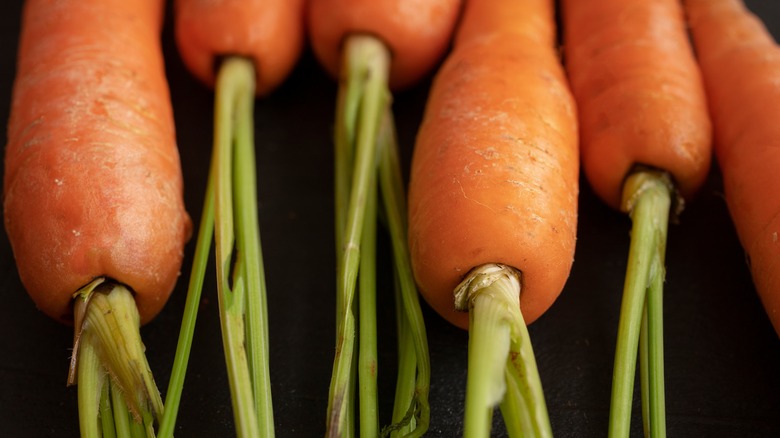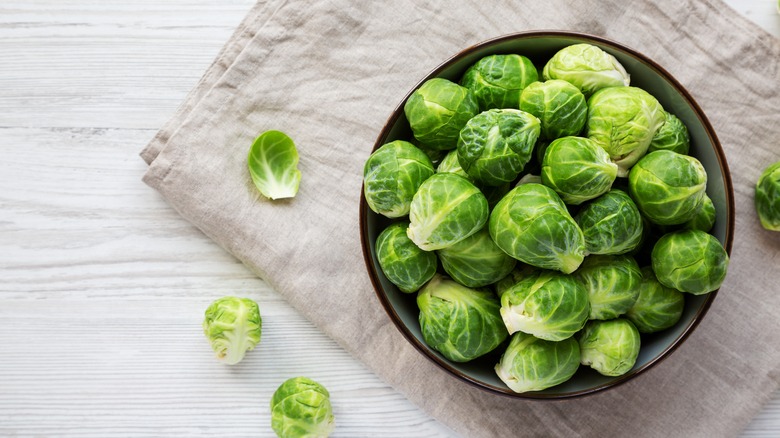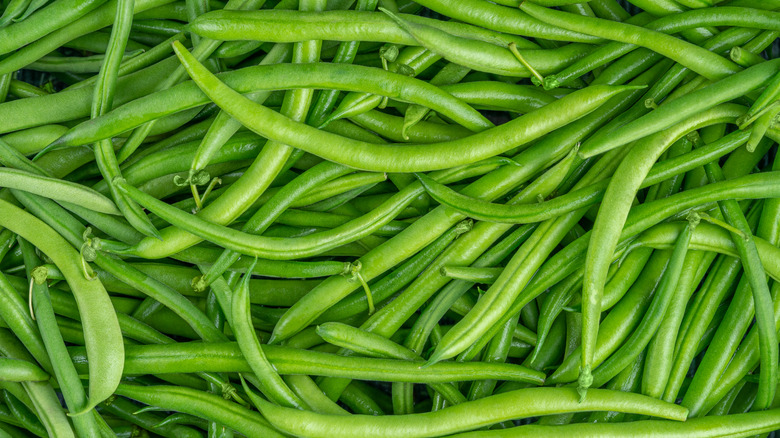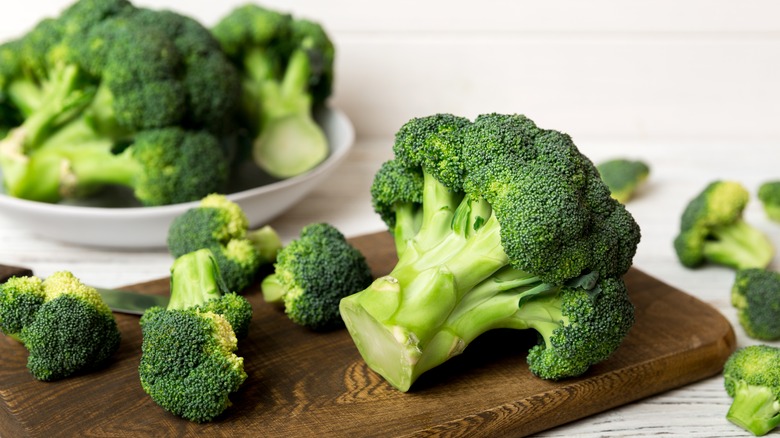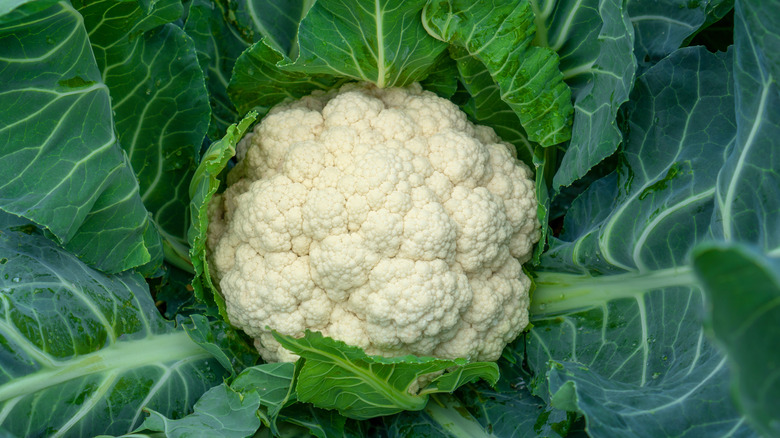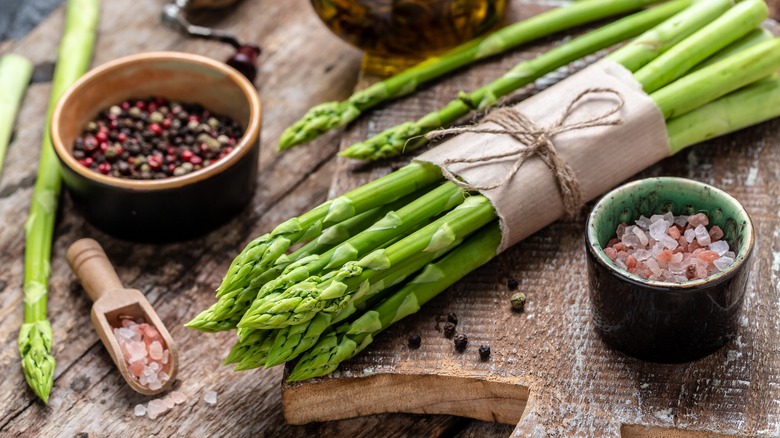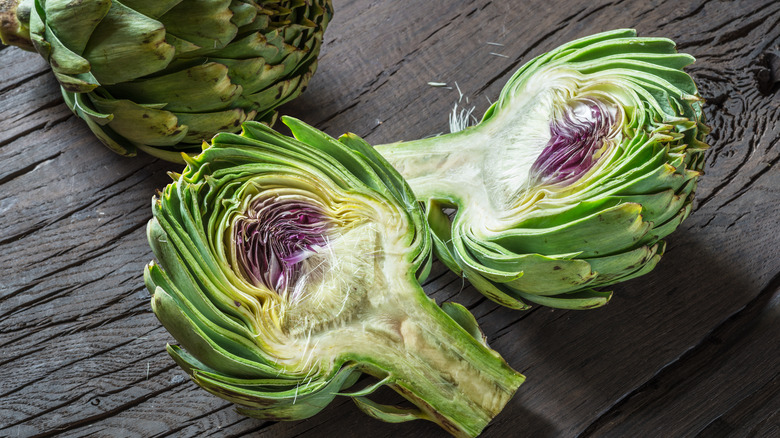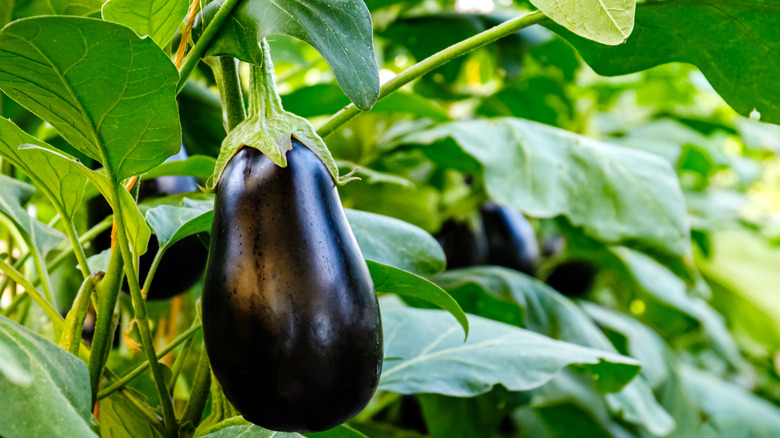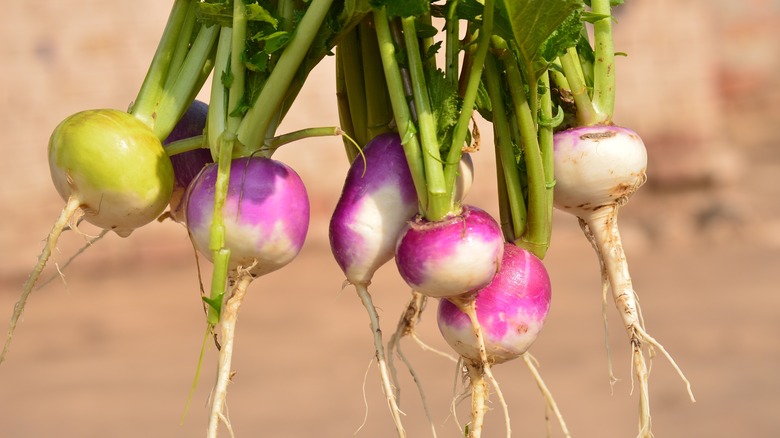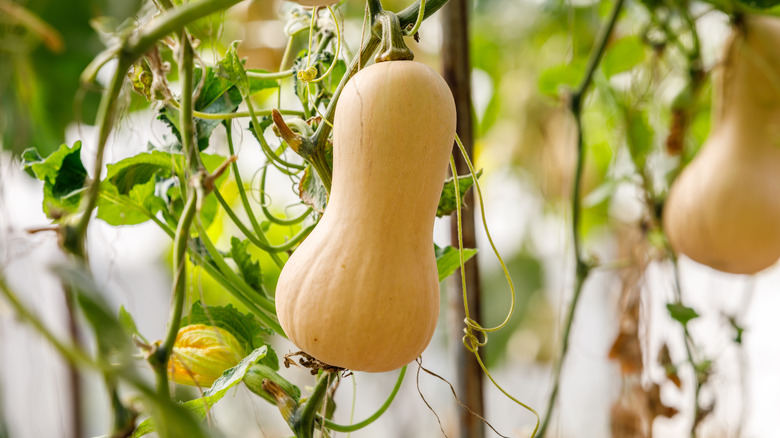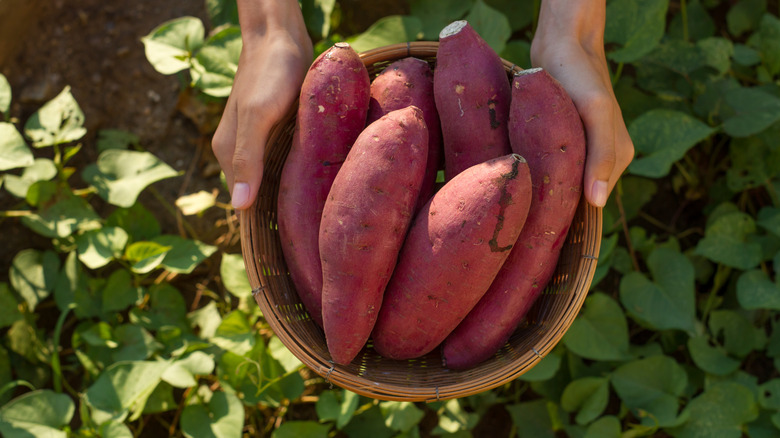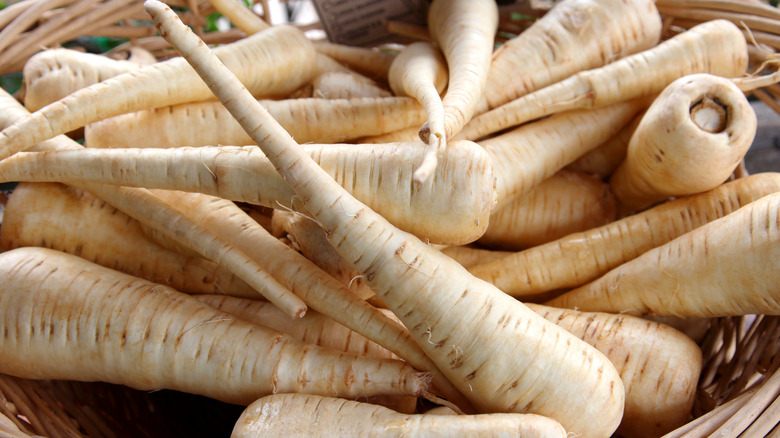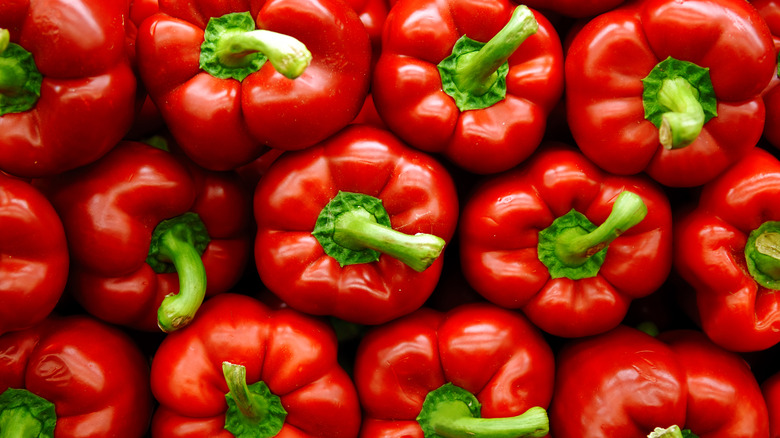14 Foods That Need To Be Parboiled Before Cooking
Parboiling is a cooking technique that involves not fully cooking foods but partially cooking by boiling them briefly. Parboiled foods still require further cooking, but parboiling has some important benefits that make it worth that extra step. From a culinary standpoint, parboiling significantly enhances the taste and texture of many foods. For example, tubers such as potatoes and carrots often have a firm interior that takes longer to cook than their exterior. Parboiling these vegetables ensures even cooking, preventing the exterior from overcooking while the interior remains undercooked. Similarly, for dishes that incorporate rice, like risottos or paellas, parboiling the rice guarantees a fluffy and separate texture, crucial for the success of the dish.
On the practical side, parboiling is a time-saving technique in the kitchen. By partially cooking foods in advance, the overall cooking time for a dish can be reduced. This is especially beneficial when preparing meals that typically have a long cooking time, such as stews or roasts. Furthermore, parboiled foods can be cooled and stored for future use, which aids in meal preparation, especially for those with busy schedules. Moreover, parboiling also aids in food safety. For foods prone to bacterial contamination, like poultry, parboiling can kill harmful bacteria, reducing the risk of foodborne illnesses.
1. Potatoes
Potatoes are versatile tubers used in many recipes, but to get the best results, parboiling them before cooking is key. Parboiling potatoes involves partially cooking them in boiling water, then draining and cooling them before adding them to a recipe. This simple extra step yields potatoes that are fluffy on the inside with a crispy exterior.
Have you noticed how some potato pieces remain harder while others disintegrate when you just chuck them into boiling water or oil? This is because potato pieces have varying thicknesses and densities. To make sure each and every piece cooks evenly, parboiling them first draws out excess starch which helps the chef in bringing all pieces to the same level of doneness when cooked the final time. Parboiling potatoes for a few minutes also makes their skins much easier to remove. The heat loosens the skin so you can peel them with less effort.
Another benefit of parboiling is that it removes excess starch, creating a fluffier final product. Since potatoes consist of starch and moisture parboiling gently heats the potatoes so their interiors become tender while their exteriors remain intact. The residual heat will continue cooking the potatoes after draining, allowing them to finish cooking uniformly. Without parboiling, potatoes tend to end up burnt on the outside and raw on the inside.
2. Carrots
Carrots are root vegetables that are delicious when cooked properly but can be tricky to get right due to their dense, fibrous nature. Parboiling helps tenderize carrots, especially younger batches with denser fibers. The hot water bath softens the fibers and pith slightly, aiding the breakdown of cell structures when the carrots are cooked. This results in more uniformly tender carrots with a less woody, mealy texture when finished cooking.
Parboiling also brightens the color of carrots and helps them retain nutrients. The brief boiling catalyzes a reaction between chlorophyll and acids in the carrots that brightens their pigments. Whether you're roasting carrots, making a creamy carrot soup, or a carrot souffle, parboiling the carrots first can really elevate the finished dish. When making carrot soup, parboiling and then sautéing them in butter allows the natural sugars in the carrots to caramelize, giving the soup more depth of flavor.
3. Brussels sprouts
Brussels sprouts are nutritious cruciferous vegetables that require some extra care and attention. Their dense, compact shape means the outer leaves tend to overcook before the center becomes tender. Parboiling the sprouts in salted water helps soften their cell walls and releases bitter flavor compounds so they dissipate in the cooking water, leaving you with mildly flavored, al dente sprouts. This also jumpstarts the cooking process, reducing the time the sprouts spend in a saucepan, skillet, or oven, limiting their exposure to excess heat that can bring out their strongest flavors and make them mushy and unappetizing.
Brussels sprouts that have been parboiled require less cooking time to finish and tend to end up with a better texture. Since they are partially tender after parboiling, they need only a quick cook over high heat to warm through and caramelize the outer leaves. This flash cooking allows them to retain some bite and not become mushy. Parboiled Brussels sprouts make an easy and delicious side dish or topping when pan-roasted with bacon and garlic. Some tasty ways to incorporate your parboiled Brussels sprouts include Brussels sprout slaw and casseroles.
4. Green beans
Green beans are a classic summer vegetable, but their slender shape makes them difficult to cook evenly. To ensure crisp-tender green beans with maximum flavor and nutrition, parboiling them is crucial. Green beans contain sugars that quickly soften when cooked, leading to limp, mushy beans. Parboiling pre-cooks the beans briefly so their interiors become tender while the exteriors remain crisp. Then chilling stops the cooking process. When cooked further, the beans need only a quick warm through, so they end up with an ideal crisp-tender texture. Without parboiling, green beans tend to end up completely soft or scorched before cooking through.
Green beans that have been parboiled take less time to prepare since they are already partially cooked. A quick stir fry, steam or sauté is all that is needed to finish tenderizing the interior and warming the beans while keeping the exterior intact. Less cooking also means fewer opportunities for their delicate nutrients to break down. For bright, fresh-tasting green beans with an ideal snap, parboiling is the way to go. Some common dishes that benefit greatly from using parboiled green beans include capellini alla primavera and spicy Szechuan green beans.
5. Broccoli
Broccoli is a highly nutritious vegetable that requires careful cooking to preserve its nutrients and ensure an ideal texture. Its dense, compact florets and stalk mean the exterior tends to overcook before the interior becomes tender. One significant advantage of parboiling broccoli is that it helps it cook evenly by allowing heat to reach the innermost layers. Raw broccoli does not conduct heat well due to its compact shape, so the outer florets tend to burn by the time the core becomes tender. Parboiling pre-cooks the broccoli so the heat has time to penetrate, then stops before the exterior is overdone. This results in tender yet still firm broccoli with vivid color. Without parboiling, broccoli tends to end up scorched or pale and mushy.
Whether adding parboiled broccoli to pasta to make broccoli alfredo, broccoli casseroles, or creamy broccoli soups, its bright color and crisp-tender texture is unparalleled. For the freshest-tasting broccoli with a perfect snap, parboiling before cooking is essential. Your broccoli will be transformed into a vibrant, nutritious morsel that the whole family will love. Simply toss with lemon juice, olive oil, garlic, and Parmesan for a healthy, delicious side dish
6. Cauliflower
Parboiling cauliflower before cooking is a vital step if you want tender yet firm florets that cook evenly every time. The dense florets of cauliflower take different times to become tender depending on their size and position. Pre-boiling the whole head in water for a few minutes first evens out this difference by giving each floret a head start.
Ultimately, you'll have better control over your cauliflower's final doneness. Whether you want al dente, tender-crisp, or meltingly soft cauliflower, parboiling removes some of the guesswork. The cauliflower "starts" are already at a defined stage, so you can cook it for the precise time needed to achieve your desired texture.
Parboiling cauliflower in advance and storing it properly in the fridge or freezer is a nice way to have more cauliflower dishes at the ready when you need them. The brief pre-cooking means the cauliflower is already partially tender, so it needs less time during reheating or thawing. This makes leftover or meal-prepped cauliflower mush-free and perfect for quick weeknight dinners. If you are interested, try making your creamy and cheesy cauliflower gratin or cauliflower fried rice for a tasty and healthy meal.
7. Asparagus
Asparagus is a wonderfully delicate and delicate spring vegetable. Its tender yet fibrous stalks can lead to limp, overcooked spears without proper technique. Whether serving parboiled asparagus as a salad, side dish, or topping, its crisp yet tender texture and vibrant green tips are unmatched. For the freshest-tasting asparagus with an ideal snap, parboiling before cooking is key.
When you parboil asparagus, you partially cook the spears in boiling water for just a few minutes. This softens the vegetable, especially the tough ends, making the whole spear more palatable and tender when finally cooked. Asparagus that has been parboiled requires less cooking to finish since it's already partially tender. A quick roast in the oven, char on the grill, or sauté over high heat is enough to warm the spears through while keeping their delicate tips intact. Less cooking also means more nutrients are preserved. For maximum nutrition, flavor, and texture, always parboil asparagus before cooking. Whether you roast, grill, or pan-fry asparagus, parboiling it first helps guarantee perfectly tender spears with concentrated flavor. Plus, parboiled asparagus turns richly browned and flavourful when pan-fried in olive oil and butter.
8. Artichokes
Parboiling artichokes involves submerging them in acidulated boiling water (water mixed with lemon juice or vinegar) until they're partially but not fully cooked, usually 10 to 15 minutes depending on size. Parboiled artichokes need only a quick bake, broil, or grill to finish since the work of prepping and cooking the tough outer leaves has already been done. As with the other items on this list, less overall cooking means more nutrients are preserved in the final dish.
Whether you are making an artichoke spinach dip, Sicilian stuffed artichokes, or a tangy pickle artichoke salad, parboiled artichokes boast an edible, tender exterior and creamy yellow heart. Parboiling is the best way to achieve the freshest-tasting artichokes with ultimate texture. Your artichokes will be transformed into a delightful delicacy you'll want to make again and again. Dip the tender leaves in lemon butter, mayonnaise, or aioli, and be sure to save the decadent heart for last.
9. Eggplants
Eggplants can have a variable texture and taste depending on the variety, age, and growing conditions. Without proper preparation, their porous, seedy interior quickly absorbs oil and collapses into mush. Parboiling eggplant helps in reducing any unwanted bitterness from its flesh. Eggplants naturally contain compounds called alkaloids that can create a bitter or astringent flavor, especially in larger specimens. By boiling the eggplant for a few minutes prior to cooking, a significant portion of these compounds will leach out into the water, leaving you with milder flavored slices or spears.
The main advantage of parboiling eggplant is that it allows it to cook evenly without getting soggy. Raw eggplant has an open cell structure, so it eagerly absorbs oil and water. Parboiling causes the cell walls to partially collapse so the eggplant absorbs less oil upon cooking. Then chilling stops cooking before the eggplant becomes mushy. This results in eggplant with a firm yet tender, creamy texture that isn't oily or slimy. Without parboiling, eggplant ends up greasy, collapsed, and soggy. Check out eggplant Parmesan, ratatouille, and vegetarian moussaka recipes if you are in the mood for a tasty aubergine dinner.
10. Turnips
Turnips have a sharp, peppery bite and dense texture when simply roasted or boiled which some find unpleasant. However, parboiling turnip pieces in boiling water before any finishing cooking method unlocks a whole new level of sweet, earthy flavor and creamy tenderness from these humble root vegetables. Raw turnips are dense and fibrous, so the exteriors tend to overcook before heat penetrates the center. Parboiling pre-cooks the turnips so the heat has time to travel inward, then stops before they become mushy. It also helps turnips retain nutrition and brighten in color. The brief cooking duration limits nutrient loss as fewer nutrients leach out into the water. The residual heat from parboiling partially cooks the turnips through to maximize their nutritional availability. Plunging in cold water will stop chlorophyll breakdown, leaving turnips an appetizing cream color.
Turnips that have been parboiled require less cooking to finish and tend to end up more tender and creamy. Since they have already been partially softened, a quick mash, roast, or sauté over high heat is enough to warm them through while achieving an ideal smooth texture.
11. Squash
Winter squash like butternut, acorn, and spaghetti squash all have a dense texture and tend to taste one-dimensional when simply roasted or boiled. Its compact shape means the exterior often overcooks before the center becomes tender. To get evenly cooked squash with a light, creamy texture, parboiling before cooking is essential. Raw squash is starchy and dense, so the outside tends to become mushy before the inside cooks. Parboiling pre-cooks the squash so the heat has time to travel inward, then stops before it collapses completely. This results in squash that is tender yet still intact with a creamy, light texture. Without parboiling, squash tends to end up with a watery, stringy texture.
Parboiling squash involves cutting it into cubes or slices and submerging it in boiling salted water until partially but not fully cooked, usually 5 to 10 minutes depending on the type. The residual heat will continue gently cooking the squash after draining. Parboiled squash needs only a quick roast, mash, or sauté to finish — its texture has already been softened but not completely broken down. Whether you are making a butternut squash risotto, a creamy butternut squash soup, or a butternut squash ravioli, parboiling will get you the texture and flavor that you so desire in your squash!
12. Sweet potatoes
Sweet potatoes are deliciously sweet root vegetables, but their starchy, fibrous flesh needs proper cooking to achieve the best texture. Their compact shape means the outside often becomes mushy before the inside is tender. To get evenly cooked sweet potatoes with a fluffy yet intact texture, parboiling before cooking is essential. Parboiling sweet potatoes helps to soften their dense and starchy texture, making them more tender and pleasing to the palate. By partially cooking the sweet potatoes in boiling water, you reduce their overall cooking time and ensure they become tender without turning mushy. The result is a delightful texture that balances softness with a slight firmness.
Whether mashing them with coconut milk and spices(check out this one-pot sweet potato curry recipe), roasting them with olive oil and chili, or topping the sweet potatoes to a turkey and cranberry shepherd's pie, parboiled sweet potatoes achieve a melt-in-your-mouth quality unmatched by other cooking methods. For sweet potatoes as nutritious as they are comforting, parboiling certainly helps the process. Your sweet potatoes will transform into a dish your whole family will love.
13. Parsnips
Parsnips have a similar woodsy flavor and texture to carrots, but many home cooks neglect to parboil them before roasting, which can leave these root vegetables overly tough and starchy. Their thick shape means the outside often becomes mushy before the inside is tender. To get evenly cooked parsnips with a creamy yet intact texture, parboiling before cooking is key. Just boil parsnip chunks for a few minutes, strain, then proceed with your recipe as usual. The magic of pre-boiling will transform your parsnips into perfectly tender yet still-firm bites with concentrated sweetness and an impeccable roasted texture that is guaranteed to elevate your parsnip dishes.
Parboiling also tends to bring out their natural sweetness. The brief boiling draws out some of the excess starch and sugars from the parsnips, concentrating their sweet flavor. This makes them taste even sweeter when roasted. Parboiled parsnips also develop a nuttier roasted flavor, and water is drawn from the parsnips, concentrating their natural sugars and starches. This allows them to caramelize more during roasting, enhancing their nutty roasted flavor.
14. Bell peppers
Bell peppers are crunchy, but their thick, dense walls require proper cooking to achieve ideal results. Their compact shape means the outside often becomes soft before the inside is tender. To get evenly cooked bell peppers with a perfect crisp-tender texture, you can — you guessed it — parboil them before cooking. Parboiled bell peppers have more versatility as an ingredient. Since they are still crunchy, they can be prepared in more ways like stir-frying, roasting, grilling, and baking. Without parboiling, bell peppers that are cooked for a long time can only be used in dishes where they will completely break down.
Parboiled bell peppers also last longer after being cooked. Their partially cooked but still firm state allows them to better retain moisture. They can be stored for several days and still added to dishes without becoming limp. Non-parboiled cooked bell peppers quickly become soggy after cooking and spoil more rapidly. Bell peppers that have been parboiled also have a stunning visual appeal. Their vibrant colors are preserved through parboiling and pop when added to dishes. Without parboiling, bell peppers can become drab and pale in color when cooked for too long. The brief cooking during parboiling retains the eye-catching red, green, and yellow hues.
Static Media owns and operates Tasting Table, The Daily Meal, and Mashed.
